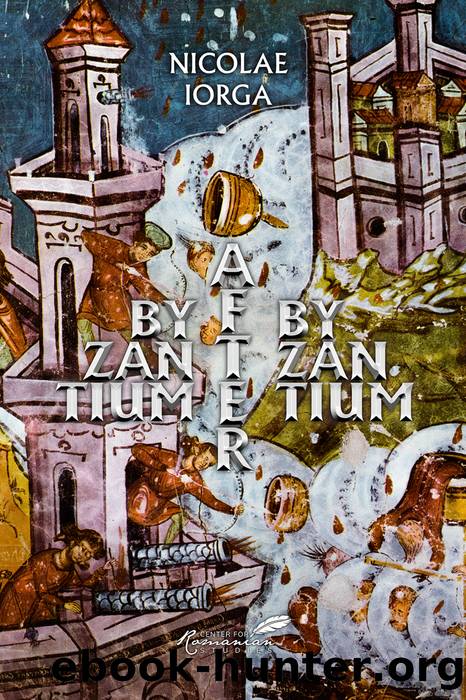Byzantium after Byzantium by Nicolae Iorga

Author:Nicolae Iorga
Language: eng
Format: epub
Publisher: Histria Books
Published: 2022-02-15T00:00:00+00:00
II. The Romanians in Constantinople
Radu Paisie or Petru from ArgeÅ â three names, of a layman, of a monk, and of a prince â was the first who, as an exile in Egypt, lived in a Byzantine world. The situation of the Romanian princes in relation to the Patriarchate in Constantinople, their character of continuators of Byzantium appeared already in this epoch in the muniment through which Radu created the new eparchy of BuzÄu âto be a parish and judgement seat where there is need of pastoral service: according to the pious faith and the Christian religion,â following the tradition established âby those before us old princes,â consulting only with âour all-holy and all-glorious father and Ecumenical Patriarch chir Jeremiah and with the other hierarchs, bishops, and abbots, and with the entire synod and with all my boyars, great and minorâ (17 September 1544).45
His successor, Mircea, dealt for a long time, as purveyor of the court in Constantinople, with commerce in sheep, in great demand, on the Danube; that is why he was nicknamed âthe Shepherd.â His wife, Chiajna, half Serbian, descendant of the BrankoviÄ family on her motherâs side, but a Moldavian on the side of her father, Petru RareÅ, kept the Greeks brought in the country by her husband; the word was that, having remained a widow, she had an impermissible relationship with one of them.46 His rival, Alexander, was, as we have said, an old Constantinopolitan, married in Pera.
From then on, the princes of the two rival families that succeeded each other left for the capital of the empire or for eastern exile places to wait for their turn on the throne: they were therefore marked by all that meant Byzantine tradition. This was the case of Petru, the son of Mircea and Chiajna, who was exiled in Alep and whose tombstone, written in an elevated Greek, was found in Asia Minor;47 it was also the case of Mihnea, the son of Alexander and his Levantine wife, who must have known Rhodes and Tripoli in Africa. An unexpected adversary, Petru Cercel, came through France and Italy from Damascus,48 his place of exile during his childhood and adolescence.
In Moldavia, Alexandru LÄpuÅneanu, driven away by the Cretan Basilikos, who aspired to rule the former Byzantine Empire, was the first of the lineage of Stephen the Great to know, through his forced exile there, the capital of the empire. We have seen that he and his wife Ruxandra, the sister of Chiajna, were generous in gifts to Mount Athos, where one can still see the portrait of this prince, in imperial dress â the richly jagged crown, set on a veil, the brocade mantle â placed between his sons Bogdan and Constantin49 â, as well as the portrait of his wife. Mount Sinai also enjoyed their generosity.50 The letter addressed by the monks at Karakalu to Ruxandra, Alexandruâs wife, who became their patron, has been preserved.51 She redeemed one of the monasteries on Athos at the time when Sultan Selim II was putting up for auction all the properties of the Orthodox Church (1568).
Download
This site does not store any files on its server. We only index and link to content provided by other sites. Please contact the content providers to delete copyright contents if any and email us, we'll remove relevant links or contents immediately.
| Belgium | France |
| Germany | Great Britain |
| Greenland | Italy |
| Netherlands | Romania |
| Scandinavia |
Room 212 by Kate Stewart(4112)
The Crown by Robert Lacey(4112)
Endurance: Shackleton's Incredible Voyage by Alfred Lansing(3852)
The Iron Duke by The Iron Duke(3649)
The Rape of Nanking by Iris Chang(3525)
Killing England by Bill O'Reilly(3459)
Joan of Arc by Mary Gordon(3264)
Say Nothing by Patrick Radden Keefe(3068)
I'll Give You the Sun by Jandy Nelson(2845)
Hitler's Monsters by Eric Kurlander(2736)
Shadow of Night by Deborah Harkness(2724)
Margaret Thatcher: The Autobiography by Thatcher Margaret(2688)
Mary, Queen of Scots, and the Murder of Lord Darnley by Alison Weir(2680)
Darkest Hour by Anthony McCarten(2650)
Blood and Sand by Alex Von Tunzelmann(2611)
Red Famine: Stalin's War on Ukraine by Anne Applebaum(2467)
Eleanor & Park by Rainbow Rowell(2398)
The One Memory of Flora Banks by Emily Barr(2350)
Book of Life by Deborah Harkness(2269)
